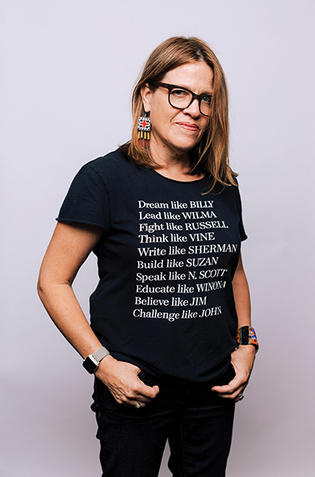
Sam Gehrke
Marie Watt ’96MFA, who creates art from cloth, invites others to sew along with her. “I like to say I set the table and I invite people to come,” she says.
View full image
Exhibiting over the last year in the Smithsonian, the Whitney, the Yale University Art Gallery, and several commercial galleries, Marie Watt ’96MFA has gained steady visibility. This May the artist, a member of the Seneca Nation with German-Scots ancestry, opens her biggest show to date. The Denver Art Museum will feature her sculptures, wall hangings, and large-scale installation works alongside those of Cannupa Hanska Luger (Mandan, Hidatsa, Arikara, Lakota, and European), in a show called Each-Other. Both artists, who are known for collaborative artmaking, will collaborate on a new, community-made piece, a massive she-wolf. Its pelt will be assembled from hundreds of stitched bandannas, created and sent in by the public.
Communal crafting and collective action are essential parts of Watt’s art practice. For almost two decades, she has been leading sewing circles open to the community, starting in her home studio in Portland, Oregon, and most recently on Zoom.
Robin Cembalest: At first, you cooked food for everyone who came by.
Marie Watt: Now I offer prints for stitches.
RC: You’ve run sewing circles for hundreds of people, incorporating their contributions into your finished artworks. Yet you still can tell their stitches apart.
MW: Embroidery floss is the thickest piece of thread—you get to see these visible markers. I love how they relate to the act of drawing and how expressive they can be.
RC: At a time of self-isolation, the circles create a framework for self-expression, collaboration, and connection. You have expressed building human relationships as one of your goals as an artist.
MW: I like to say I set the table and I invite people to come. It’s about the energy in the room and the conversations that happen when your eyes are diverted and you’re working with something as familiar and intimate as cloth.
RC: For your she-wolf, you have a timely prompt. You’re asking people to use bandannas. And you’re inviting them to embroider a word or an image that expresses how they feel or where they’re at in this moment.
MW: We’re interested in how we’re using the cloth in this moment as a shield—something that conceals our identity, and that protects our faces from germs.
RC: Your 2012 sculpture Skywalker/Skyscraper (Axis Mundi), a tower of blankets, is in the Whitney Museum’s current show devoted to craft in recent art. The title plays off the double cultural meaning of the word Skywalker—a beloved Star Wars character you grew up with, and a reverent name given to Native American ironworkers.
MW: In 2009 my husband and I and our daughter moved to New York. I’d grown up around conifers and totem poles. They were replaced by skyscrapers and scaffolding. I had always admired the ironworkers in our family and the Iroquois nation. I realized I was living where there were so many ironworkers in the ’50s.
RC: Another Skywalker piece, Antipodes (Study in dusty rose), is in the inaugural show of K Art, a commercial art gallery in Buffalo, New York, founded by Dave Kimelberg, a member of the Seneca Nation of Indians (Bear Clan).
MW: I’m super excited that K Art exists. Just to have an indigenous-run contemporary art gallery—but the fact that it is owned by a Seneca entrepreneur and art and culture advocate! It’s really important and timely.
RC: This fall, the Yale Art Gallery will include your 2015 piece First Teachers Balance the Universe, Part I: Things That Fly (Predator), in a show celebrating 150 years of women at the university. The gallery, which acquired the work in 2018, has already shown it once: the massive textile was an anchor of Place, Nations, Generations, Beings: 200 Years of Indigenous North American Art, the groundbreaking exhibition organized by students Katherine Nova McCleary (Little Shell Chippewa-Cree) ’18; Leah Tamar Shrestinian ’19; and Joseph Zordan (Bad River Ojibwe) ’19.
MW: I wasn’t emotionally prepared for how significant that show was. As a graduate student at Yale, I had moved to New Haven from New Mexico, where I was in this incredibly rich and diverse indigenous community. I really tried hard to find the Native community at Yale, and it was impossible honestly to locate it.
What makes me so optimistic is that I could see a change. I could see indigenous students leading this change and making the university accountable. They rallied so many people together. Working in community and amplifying our stories is part of our DNA.
 loading
loading